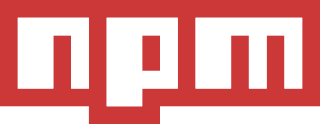
JavaScript, often abbreviated as JS, is a programming language and core technology of the Web, alongside HTML and CSS. 99% of websites use JavaScript on the client side for webpage behavior.
In computer science, a preprocessor is a program that processes its input data to produce output that is used as input in another program. The output is said to be a preprocessed form of the input data, which is often used by some subsequent programs like compilers. The amount and kind of processing done depends on the nature of the preprocessor; some preprocessors are only capable of performing relatively simple textual substitutions and macro expansions, while others have the power of full-fledged programming languages.
Programming languages can be grouped by the number and types of paradigms supported.
The following table lists the various web template engines used in Web template systems and a brief rundown of their features.
JSDoc is a markup language used to annotate JavaScript source code files. Using comments containing JSDoc, programmers can add documentation describing the application programming interface of the code they're creating. This is then processed, by various tools, to produce documentation in accessible formats like HTML and Rich Text Format. The JSDoc specification is released under CC BY-SA 3.0, while its companion documentation generator and parser library is free software under the Apache License 2.0.
Svelte is a free and open-source component-based front-end software framework, and language created by Rich Harris and maintained by the Svelte core team members.
A single-page application (SPA) is a web application or website that interacts with the user by dynamically rewriting the current web page with new data from the web server, instead of the default method of a web browser loading entire new pages. The goal is faster transitions that make the website feel more like a native app.

Google Closure Tools is a set of tools to help developers build rich web applications with JavaScript. It was developed by Google for use in their web applications such as Gmail, Google Docs and Google Maps. As of 2023, the project had over 230K LOCs not counting the embedded Mozilla Rhino compiler.

Node.js is a cross-platform, open-source JavaScript runtime environment that can run on Windows, Linux, Unix, macOS, and more. Node.js runs on the V8 JavaScript engine, and executes JavaScript code outside a web browser.

npm is a package manager for the JavaScript programming language maintained by npm, Inc., a subsidiary of GitHub. npm is the default package manager for the JavaScript runtime environment Node.js and is included as a recommended feature in the Node.js installer.
AngularJS is a discontinued free and open-source JavaScript-based web framework for developing single-page applications. It was maintained mainly by Google and a community of individuals and corporations. It aimed to simplify both the development and the testing of such applications by providing a framework for client-side model–view–controller (MVC) and model–view–viewmodel (MVVM) architectures, along with components commonly used in web applications and progressive web applications.
Pretty Diff is a language-aware data comparison utility implemented in TypeScript. The online utility is capable of source code prettification, minification, and comparison of two pieces of input text. It operates by removing code comments from supported languages and then performs a pretty-print operation prior to executing the diff algorithm. An abbreviated list of unit tests is provided. The documentation claims the JavaScript pretty-print operation conforms to the requirements of JSLint.

Elm is a domain-specific programming language for declaratively creating web browser-based graphical user interfaces. Elm is purely functional, and is developed with emphasis on usability, performance, and robustness. It advertises "no runtime exceptions in practice", made possible by the Elm compiler's static type checking.
JavaScript templating refers to the client side data binding method implemented with the JavaScript language. This approach became popular thanks to JavaScript's increased use, its increase in client processing capabilities, and the trend to outsource computations to the client's web browser. Popular JavaScript templating libraries are AngularJS, Backbone.js, Ember.js, Handlebars.js, Vue.js and Mustache.js. A frequent practice is to use double curly brackets to call values of the given key from data files, often JSON objects.

Ember.js is an open-source JavaScript web framework that utilizes a component-service pattern. It is designed with the aim of allowing developers to create scalable single-page web applications by incorporating common idioms, best practices, and patterns from other single-page-app ecosystem patterns into the framework.
Web Components are a set of features that provide a standard component model for the web allowing for encapsulation and interoperability of individual HTML elements. Web Components are popular approach to build microfrontends.

React is a free and open-source front-end JavaScript library for building user interfaces based on components. It is maintained by Meta and a community of individual developers and companies.

Vue.js is an open-source model–view–viewmodel front end JavaScript library for building user interfaces and single-page applications. It was created by Evan You, and is maintained by him and the rest of the active core team members.
gulp is an open-source JavaScript toolkit, used as a streaming build system in front-end web development.

Deno is a runtime for JavaScript, TypeScript, and WebAssembly that is based on the V8 JavaScript engine and the Rust programming language. Deno was co-created by Ryan Dahl, who also created Node.js.








